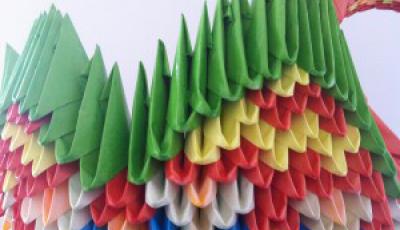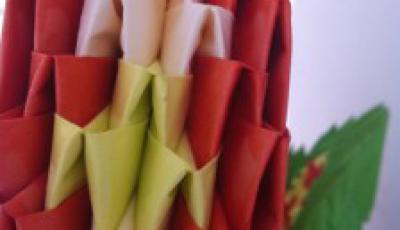This swan was made in Yarl’s Wood in 2011, by a long-term UK resident from Nigeria.

Pam, (not her real name), was taught by a Chinese woman in the removal centre how to make a range of decorative objects out of brightly coloured paper. Encouraged by the officer in charge of arts and crafts, women from all around the world learned how to make flowers, stars, animals and vases. Paper folding, they explained, could be done in their rooms at night, when they had difficulty sleeping. All they needed to do was cut the paper in strips in the art and craft room, for assembly later on. Once the model was complete, they returned to the art and craft room to douse it in PVA glue, which keeps it firm and makes it last.

How might we interpret material objects like this? What can they teach us about the experience of detention and deportation? What might they tell us about belonging and migration control?
As it turns out, they can teach us a lot. First of all, they direct our attention to interpersonal relations among the detainees and also with the staff. These items, when I was last in Yarl’s Wood, could be found all over the centre, in offices as well as in women’s bedrooms. Women gave them to one another and to staff, and sent them out to their family members. In so doing they expressed care for one another and also respect. Gift giving depends on the relationship, and also, sometimes, on the item. Paper stars were considered good luck. Women made them and gave them away when their anxieties about their immigration case were high.
Objects like this also reveal IRCs to be sites of cultural transfer. It was not just this particular Nigerian woman who was taught by a Chinese friend, but British staff members too, and women of other nationalities. As each new person learned the basic techniques, they altered them. In this case, Pam greatly increased the size. Most items made by folding paper are small. Flowers are life size, meant to resemble a real bouquet. Birds and animals fit in the palm of your hand. This swan, however, stands tall, at more than 50 cm high. No long simply decorative, it can be used as a basket.

Pam’s swan directs our attention to the relationship between inside and outside detention. Within Yarl’s Wood, paper folding offered Pam a means of passing the time, making friends and coping with loneliness and insomnia. In the longer term, however, she was interested in it as a potential skill. Facing removal, Pam was determined to set up a market stall in Lagos on her return selling paper goods like this, as well as handmade cards and other items.
Criminologists do not usually include visual or material culture in their research. For the most part, when they have done, it is has been in relation to images of crime and punishment. As this localised example suggests however, much can be learned from everyday objects about incarceration as well.
Share:








